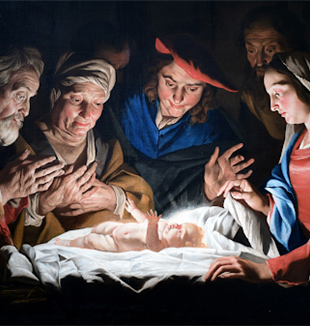
The Grace of Being Guided this Advent
A presentation of the December Book of the Month: Jesus of Nazareth: The Infancy Narratives by Pope Benedict XVI.During the Thanksgiving break, I had the opportunity to visit the National Gallery of Art in Washington, D.C. to explore the history of landscape paintings by American born artists. We had a very knowledgeable guide who shared her passion for this chapter of American art. Through her presentation, I felt like I was being taken by the hand and brought to see the depth of what the artists’ communicated through their works. The guide’s wisdom and love opened many new horizons and enabled me to enter into the paintings.
I had a similar experience reading Pope Benedict XVI’s book Jesus of Nazareth: The Infancy Narratives. I was led by the late pontiff through the many fascinating details of the Evangelists Matthew and Luke’s descriptions of Jesus’ birth. Every page is saturated with the wisdom and lifelong study and reflection of this great man of the Church. Through this short book, he brought to life the biblical texts like no one before and invited me to look at Christ from the perspective of his personal faith. As with the gallery guide, I began to see what is before me through his eyes.
For those who are unfamiliar with this book, it is the third and final volume of Jesus of Nazareth series, which he said was “his personal search for the figure and message of Jesus of Nazareth.” It was published for Advent 2012. He describes it as a small “antechamber” to the earlier volumes (Jesus of Nazareth (2007), Jesus of Nazareth. Holy Week (2011). As we enter the time of Advent, I would like to share three fundamental theses that caught my attention while reading the book.
“Hail, favored one! The Lord is with you” (Luke 1:28). While commenting on the mystery of the Annunciation, Benedict XVI begins by revealing the significance of what he calls the first word of the New Testament: hail (chaĩre). The Archangel Gabriel does not greet the Virgin Mary with the traditional Hebrew greeting shalom (peace be with you), but with the Greek formula chaĩre. This Greek term translates as “rejoice.” The same expression is used again by the angel who says to the shepherds: “I bring you good news of a great joy” (Luke 2:10). Ratzinger notes that it is used again in John’s Gospel at the encounter with the risen Lord: “The disciples were glad when they saw the Lord” (20:20). From this he deduces that from the beginning to the end of Jesus’s life joy appears as the essential gift of the Holy Spirit, it is the true gift of the Redeemer. Joy is the fundamental word that accompanies the key moments of Jesus’ life.
“Behold, I am the handmaid of the Lord. Let it be done to me according to your word” (Luke 1:38). Reflecting on Mary’s response to the angel, Benedict XVI returns to a medieval Advent homily by Bernard of Clairvaux to reveal what he refers to as the drama of Mary’s “yes” to the Lord. After the error of our first parents, the whole world was shrouded in darkness, under the dominion of death. Now God seeks to enter the world anew. He knocks at Mary’s door. He needs human freedom. The only way he can redeem man, who was created free, is by means of a free “yes” to his will. In creating freedom, he made himself in a certain sense dependent on man. His power is tied to the unenforceable “yes” of a human being. In his homily, St. Bernard portrays heaven and earth as if holding its breath at the question to Mary. Will she say yes? She hesitates… will her humility hold her back? Just this once – Bernard tells her – do not be humble but be daring! Give us your “yes”! The late pontiff describes this moment as if the whole celestial court of angels were present, sitting on the edge of their seats (or wings!) waiting eagerly for Mary’s response. I often think of this page while visiting the sick in the hospital and proposing to those who have been away from the sacraments for decades to return by going to Confession. I imagine having the saints and angels being present with me who are eagerly awaiting the response, and the great joy and celebration, when they agree to receive the sacrament.
“Mary will bear a son, and you shall call his name Jesus, for he will save his people from their sins” (Matthew 1:21). Benedict XVI also reminds the reader to not lose sight of the fundamental reason for the mystery of Christmas. God became man to save us from our sins. At the time of Jesus’ birth, the prevailing expectations of salvation were focused upon Israel’s concrete suffering, which pointed to the reestablishment of the Davidic kingdom and of Israel’s freedom. For many people at that time, and in our time as well, the promise of the forgiveness of sins and restored communion and friendship with the Father seem too little or too abstract. In the celebration of Christmas, we do not expect Christ to meet our deepest existential needs and for us to be embraced with the gaze of mercy. Yet he came precisely for this, to forgive our sins and restore us to communion with ourselves, with others and with God.
As we begin the Advent journey this year which will bring us to celebrate the mystery of Christmas, let us ask for the grace to be guided by the wisdom of the Church and her great saints, so that we can welcome anew and experience firsthand the great joy of being the Father’s redeemed children.